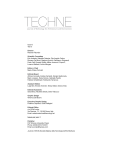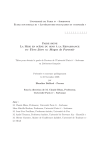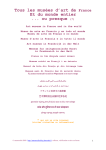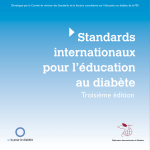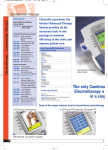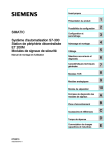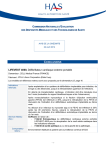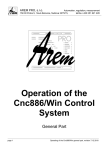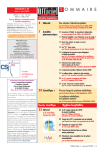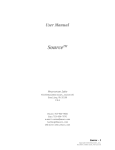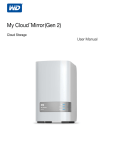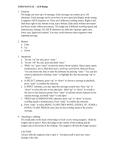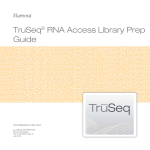Download Cat. # BK126 - Cytoskeleton
Transcript
Version 2.4 02/25/15 G-LISA™ Rac1 Activation Assay Biochem Kit™ (Luminescence Based) Cat. # BK126 ORDERING INFORMATION To order by phone: (303) - 322 - 2254 To order by Fax: (303) - 322 - 2257 Technical assistance: (303) - 322 - 2254 World Wide Web: www.cytoskeleton.com Email address: [email protected] Facility address: Cytoskeleton, Inc., 1830 S. Acoma Street, Denver, CO 80223. U.S.A. 1 Version 2.4 02/25/15 2 Version 2.4 02/25/15 MANUAL CONTENTS Section I Introduction Background …………………………………….. The Rac1 G-LISA™ Advantage ………………….. Assay Principle …………………………………….. 5 5 6 Section II Purchaser Notification…………………………..……. 7 Section III Kit Contents ……………………………………….…. 8 Section IV Reconstitution and Storage of Components …….……. 9 Section V Important Technical Notes A: Updated Version (2.0) Review …………….……. B: Growth and Treatment of Cell Lines ..………. C: Assay Preparation For G-LISA™ ……….……….…. D: Timing and Intensity of Rac1 Activation ………..….. E: Rapid Processing of Cells ……………………………. F: Protein Concentration Equivalence …………..……… G: Assay Linearity …………………………..…….……. H: Use of a Multi-channel Pipettor ……………….….… I: Removal of Solutions from Wells ………………..…. J: Plate Shaker Recommendations …………………...… K: Luminometer Settings ……………………..……..….. L: Assay Optimization of Antibody Concentrations ……. 10 11 12 13 13-14 14 14 15 15 15 15 16 Assay Protocol STEP 1: Assay Preparation …………………………. STEP 2: Lysate Collection ………………………….. STEP 3: G-LISATM Assay ………………………….. 17 17-18 19-21 Section VII Data Analysis ……………………….………………. 22 Section VIII Troubleshooting Guide …………….....……………. 23 Section IX References .…….………………….……………….. . 24 Section X G-LISATM Citations ……………………………....... 24 Section XI Related Products ……………….…………………….. 25 APPENDICES Appendix 1 Staining protocol for F-actin …………………………. 26 Appendix 2 Experiment Record Sheet …………………………….. 27 Appendix 3 Plate Record Template …………..……………………. 28 Section VI 3 Version 2.4 02/25/15 4 Version 2.4 02/25/15 Section I: Introduction Background The Rho family of small GTPases consists of at least 20 members, the most extensively characterized of which are the Rac1, RhoA and Cdc42 proteins (1). In common with all other small GTPases, the Rho family proteins act as molecular switches that transmit cellular signals through an array of effector proteins. This family is involved in a wide range of cellular responses, including cytoskeletal reorganization (2-3), regulation of transcription (4), cell migration (5), cellular transformation and metastasis (6). The Rho switch operates by alternating between an active, GTP-bound state and an inactive, GDP-bound state. Understanding the mechanisms that regulate activation / inactivation of the GTPases is of obvious biological significance and is a subject of intense investigation. The fact that Rho family effector proteins preferentially recognize the GTP bound form of the protein (7) has been exploited experimentally to develop a powerful affinity purification assay that monitors Rho protein activation (8,9). Traditionally, the Rac1 activation assay has been performed using a pull-down method, wherein the Rac-GTP binding domain (RBD) of a Rac1 effector is coupled to agarose beads, allowing affinity based detection of the active Rac1 in biological samples (9). This method suffers from several drawbacks such as being time consuming, requiring large amounts of total cellular protein, being limited in the number of samples that can be handled simultaneously and yielding only semi-quantitative results. Moreover, since all other commercially available Rac1 antibodies also recognize Rac2 and 3 and in some cases Cdc42, activation assays employing these antibodies will not detect Rac1 specific activation. Cytoskeleton Inc. has developed a monoclonal antibody that only recognizes Rac1; not Rac2, Rac3, Cdc42 or other small GTPases (see Cat. # ARC03 for details on this unique antibody). It is now accepted that Rac isotypes often exhibit isotype specific functions (11). With this specific antibody in the G-LISA™ kit, researchers can now specifically detect Rac1 activation in biological samples. The Rac1 G-LISA™ Advantage With the new G-LISA™ kit (patent# 7,763,418B2) you can now measure Rac1 activation from cell and tissue samples in less than 3 h. G-LISA™ requires only 1-5% of the material needed for a conventional pull-down assay. You will also be able to handle large sample numbers and generate quantitative results. The G-LISA™ advantages are summarized in Table 1. Table 1: The G-LISA™ Advantage Traditional pulldown G-LISA™ Assay Time 10-12 h (2 days) <3 h Cell material per assay 0.5-2 mg protein (100 mm plate) 10-50 µg protein (12-well plate) Lysate clarification needed* Yes No Sample handling Up to 10 samples Up to 96 samples (or more) Quantitative Data** Semi Yes High throughput compatible No Yes Specificity Rac1, 2, 3 or Cdc42 Rac1 only * Clarification is still recommended for low sample numbers. HTS applications that omit clarification have been developed. ** Numerical readouts and fewer sample handling steps make this assay more quantitative. 5 Version 2.4 02/25/15 Section I: Introduction, continued Assay Principle The Rac1 G-LISA™ kit contains a Rac-GTP-binding protein linked to the wells of a 96 well plate. Active, GTP-bound Rac1 in cell lysates will bind to the wells while inactive GDP-bound Rac1 is removed during washing steps. The bound active Rac1 is detected with a Rac1 specific antibody and luminescence. The degree of Rac1 activation is determined by comparing readings from activated cell lysates versus non-activated cell lysates. Inactivation of Rac1 is generally achieved in tissue culture by a serum starvation step (see Section V: Important Technical Notes, A: Growth and Treatment of Cell Lines). A basic schematic diagram of the steps involved in the G-LISA™ is shown in Figure 1. Typical G-LISA™ results are shown in Figure 2. Figure 1: Simple and Quick Protocol Figure 2: Typical G-LISA™ Results Schematic diagram of G-LISATM assay 14000 RLU RLU STEP 1: Cell lysis. 10 cm plate, 6 or 12-well plate depending on signal intensity. STEP 2: Incubate lysate in Rac-GTP affinity plate for 30 min. 12000 10000 8000 6000 4000 2000 STEP 3: Detect the bound Rac1-GTP through antibody recognition. 0 SS EGF Rac1 activation by EGF measured by G-LISA™. Swiss 3T3 cells were serum starved (SS) for 24 h and treated with EGF (10 ng/ml for 2 min). 20 µg of cell lysates were subjected to the G-LISA™ assay. Data was read at 150 gain, 10 ms integration time on a Tecan GmbH SpectroFluor Plus. STEP 4: Develop the signal with luminescence detection reagents. 6 Version 2.4 02/25/15 Section II: Purchaser Notification Limited Use Statement The G-LISATM kits are based on patented technology developed at Cytoskeleton Inc. (Patent# 7,763,418B2). The purchase of this product conveys to the buyer the non-transferable right to use the purchased amount of product and components of product in research conducted by the buyer. The buyer can not sell or otherwise transfer this product or any component thereof to a third party or otherwise use this product or its components for commercial purposes. Commercial purposes include, but are not limited to: use of the product or its components in manufacturing; use of the product or its components to provide a service; resale of the product or its components. The terms of this Limited Use Statement apply to all buyers including academic and for-profit entities. If the purchaser is not willing to accept the conditions of this Limited Use Statement, Cytoskeleton Inc. is willing to accept return of the unused product with a full refund. 7 Version 2.4 02/25/15 Section III: Kit Contents This kit contains enough reagents for 96 assays. You can run anywhere from 2 to 96 samples at a time for your own convenience. Table 2 summarizes the kit contents. Table 2: Kit Contents Reagents Cat. # or Part # * Quantity Storage 96 well Rac-GTP binding plate Part # GL63 12 strips of 8 wells each Anti-Rac1 antibody (Recognizes Rac1 only, also available as Cat. # ARC03) Secondary antibody - horse radish peroxidase conjugate (HRP) Rac1 control protein (constitutively active Rac1) Cell Lysis Buffer Part # GL07 2 tubes, lyophilized Desiccated 4°C Stable for 6 months Desiccated 4°C Stable for 3 months Part # GL02 1 tube, lyophilized Part # RCCA 12 tubes, lyophilized Part # GL36 1 bottle, lyophilized Binding buffer Part # GL46 1 bottle, lyophilized Wash Buffer Part # GL38 1 bottle, lyophilized Antigen Presenting Buffer Part # GL45 1 bottle, 30 ml Antibody Dilution Buffer Part # GL40 1 bottle, lyophilized HRP Detection Reagent A Part # GL41 1 bottle, 3.5 ml HRP Detection Reagent B Part # GL42 1 bottle, 3.5 ml Precision Red™ Advanced Protein Assay Part # GL50 (available in 500 ml size Cat. # ADV02) Cat. # PIC02 1 bottle, 100 ml Protease Inhibitor Cocktail Desiccated 4°C Stable for 6 months Desiccated 4°C Stable for 6 months Desiccated 4°C Stable for 1 year Desiccated 4°C Stable for 1 year Desiccated 4°C Stable for 6 months Room temperature Stable for 6 months Desiccated 4°C Stable for 6 months 4°C Stable for 6 months 4°C Stable for 6 months Room temperature Stable for 6 months 1 tube, lyophilized Desiccated 4°C Stable for 6 months * Items with Part numbers (Part #) are not sold separately and are available only in kit format. Items with Catalog numbers (Cat. #) are available separately. The reagents and equipment that are required but not supplied: Cold 4°C PBS buffer (10 mM phosphate buffer pH 7.4, 140 mM NaCl, 3 mM KCl). Cell scrapers Multi-channel or multi-dispensing pipettor for 25-200 µl range. Multi-channel pipettor solution basins (available from VWR Cat. # 21007-970). Used for liquid handling. Two orbital microplate shakers (VWR, Cat. # 57019). Optimal shaker speed is 400 rpm (200 rpm is the minimal speed required). One at room temperature and one at 4°C. Microplate luminometer (see Section V: Important Technical Notes for information on settings etc.) 8 Version 2.4 02/25/15 Section IV: Reconstitution and Storage of Components Many of the components of this kit have been provided in lyophilized form. Prior to beginning the assay you will need to reconstitute several components as shown in Table 3: Table 3: Component Storage and Reconstitution Kit Component Reconstitution Rac-GTP binding 96 well plate Anti-Rac1 antibody Secondary antibody HRP Storage Conditions It is imperative to keep the plate in the sealed desiccant bag with desiccant at all times. Reconstitution is not necessary prior to the start of the assay. The protective white powder pellet in each well of the plate may become detached from the bottom of the well during shipping. This will not affect the assay performance. Pellets should be tapped to the bottom of the well prior to resuspension. Resuspend one tube in 40 µl PBS. Antigen Presenting Buffer Centrifuge briefly to collect the pellet in the bottom of the tube. Dissolve the powder in 80 µl of PBS. Do not use sodium azide in combination with this antibody as it will inactivate the HRP. Each tube is good for one experiment. Reconstitution is not necessary until starting the assay (see Table 4). Reconstitute in 100 ml of sterile distilled water. This may take 5-10 min to resuspend. Use a 10 ml pipette to thoroughly resuspend the buffer. Reconstitute in 8 ml of sterile distilled water. This may take a few minutes to resuspend. Reconstitute in 1000 ml of distilled water. This will take 45-60 min to resuspend. A magnetic stir bar and stir plate can be used to help resuspension. No reconstitution necessary. Antibody Dilution Buffer Reconstitute in 15 ml of sterile distilled water. HRP Detection Reagent A No reconstitution necessary. HRP Detection reagent B No reconstitution necessary. Precision Red™ Advanced Protein Assay Protease Inhibitor Cocktail No reconstitution necessary. Rac1 control protein (12 tubes) Cell Lysis Buffer Binding Buffer Wash Buffer Reconstitute in 1 ml of dimethyl sulfoxide (DMSO) for 100 x stock. 9 Store desiccated at 4°C or room temperature Stable for 6 months Store at 4°C Stable for 3 months Store at 4°C Stable for 6 months Store desiccated at 4°C Stable for 6 months Store at 4°C Stable for 1 year Store at 4°C Stable for 1 year Store at room temperature Stable for 6 months Store at room temperature Stable for 6 months Store at 4°C Stable for 6 months Store at 4°C Stable for 6 months Store at 4°C Stable for 6 months Store at room temperature Stable for 6 months Store at 4°C for 6 month stability. Store at -70°C for 1 year stability. Version 2.4 02/25/15 Section V: Important Technical Notes A. Updated Version (2.0) Review The following updates from version 1.9 should be noted: 1) The positive control protein RCCA has been increased from 1ng per well to 2ng per well. This gives a signal that is close to the upper range of assay sensitivity. 10 Version 2.4 02/25/15 Section V: Important Technical Notes, continued B. Growth and Treatment of Cell Lines The health and responsiveness of your cell line is the single most important parameter for the success and reproducibility of Rac1 activation assays. Time should be taken to read this section and to carefully maintain cell lines in accordance with the guidelines given below. Adherent cells should be ready when they are 50-70% confluent. Non-adherent cells should be ready at approximately 3 x 105 cells per ml. Briefly, cells are seeded at 5 x 104 per ml and grow for 3 days. Serum starvation or other treatment will be performed when they are 50% confluent (see Appendix 1). When possible, the untreated samples should have cellular levels of Rac1 activity in a “controlled state”. For example, when looking for Rac1 activation the “controlled state” cells could be serum starved. Serum starvation will inactivate cellular Rac1 and lead to a much greater response to a given Rac1 activator. A detailed method for serum starvation is given in Appendix 1. Cells should also be checked for their responsiveness (“responsive state”) to a known stimulus. In many cases poor culturing technique can result in essentially non-responsive cells. An example of poor culturing technique includes the sub-culture of cells that have previously been allowed to become overgrown. In general, cells grown to >80% confluence should not be used for Rac1 activation studies. To confirm the “controlled state” and “responsive state” of your cells it is a good idea to include a small coverslip in your experimental tissue culture vessels and analyze the “controlled state” cells vs. the “responsive state” cells by rhodamine-phalloidin staining of actin filaments. A detailed method for actin staining is given in Appendix 1. Rac1 activation causes the formation of characteristic membrane ruffles (10). If you are having difficulty determining a “controlled state” for your experiment then contact technical assistance at 303-322-2254 or e-mail [email protected]. 11 Version 2.4 02/25/15 Section V: Important Technical Notes, continued C. Assay Preparation For G-LISA™ It is critical to get the assay components ready before preparing cell lysates or thawing previously prepared lysates, as the GTP-bound form of Rac1 is very labile and should be assayed as soon as possible after preparation. Table 4: Assay Preparation for G-LISA™ Reagent Preparation Rac-GTP binding 96 well plate 1) 2) Remove plate from 4°C and keep in its protective bag, place on your bench at room temperature for 30 min. Do not remove the plate (or strips) from the bag until immediately prior to the experiment. Distilled water 30 ml placed on ice. Protease Inhibitor Cocktail Lysis Buffer Keep at room temperature. 1) 2) 3) 4) 5) 6) Determine volume of Lysis Buffer needed per culture vessel by looking at Table 5. Determine total volume of Lysis Buffer needed by multiplying the lysis volume per culture vessel (µl) by number of vessels x 1.3 (see Table 5 for guidelines). Aliquot this volume of Lysis Buffer into a clearly labeled tube and place in ice. Add 10 µl of protease inhibitor cocktail per ml of aliquoted Lysis Buffer. Mix well and leave on ice. Lysis Buffer needs to be ice cold. Binding Buffer Embed bottle in ice. Rac1 control protein Dissolve one tube in 500 μl Lysis Buffer and leave on ice. This solution is good on ice for up to 8 h. PBS Phosphate buffered saline is not provided in the kit. It should be prepared prior to the assay and placed on ice for at least 30 min to ensure that it is ice cold. Anti-Rac1 antibody Have primary antibody stock ready on ice. For each 8-well strip, you will need to mix 2 µl antibody with 500 µl Antibody Dilution Buffer. This dilution step should be performed just prior to use as detailed in assay protocol. Secondary antibody Have secondary antibody stock ready on ice. For each 8-well strip, you will need to mix 2.5 µl antibody with 500 µl Antibody Dilution Buffer. This dilution step should be performed just prior to use as detailed in assay protocol. Antibody Dilution Buffer Wash Buffer Place reconstituted buffer on the bench and use at room temperature. Antigen Presenting Buffer HRP Detection Reagents A and B Place on the bench and use at room temperature. Precision Red™ Advanced Protein Assay Reagent Place on the bench and use at room temperature. Place on the bench and use at room temperature. This can be removed from 4°C and placed on your bench at room temperature. For each 8-well strip, mix 250 µl of each reagent in a new tube. Make sure to use separate pipette tips for dispensing each solution. 12 Version 2.4 02/25/15 Section V: Important Technical Notes, continued D. Timing and Intensity of Rac1 Activation Upon stimulation, Rac1 proteins are generally activated very rapidly and transiently. Maximal activation ranges from 30 s to 30 min and declines thereafter to basal levels. For potent activators such as EGF or PDGF, the intensity of maximal Rac1 activation over “control state” (serum starved) cells is generally in the order of 2-5 fold (10). However, using a single time point you are more likely to miss this maximum activation peak. It is therefore critical to take timed samples for at least the first experiment with an unknown activating entity. Recommended time points are 0, 1, 3, 6, 12 and 30 min, which fit nicely into a 6 well culture plate (The time course is also recommended for Rac1 inactivation studies). In practical terms the timed experiment should be performed sequentially. This allows rapid processing of each single time point. Once one time point lysate is collected, it should be snap frozen in “experiment sized” aliquots immediately and kept at -70oC. The G-LISA™ kit uses 25 µl of lysate (0.25-2 mg/ml lysate protein concentration) per assay. We recommend duplicate or triplicate samples per timepoint or condition, therefore 60-100 µl aliquots are recommended for snap freezing. E. Rapid processing of cells GTP bound (active) Rac1 is a labile entity, the bound GTP is susceptible to hydrolysis by Rac-GAPs during and after cell lysis resulting in Rac1 inactivation. It is reported that the Rac1 hydrolysis rate is faster than that of RhoA (12). Rapid processing at 4°C is essential for accurate and reproducible results. The following guidelines are useful for rapid washing of cells. Washing 1. Retrieve culture dish from incubator, immediately aspirate out all of the media and place firmly on ice. 2. Immediately rinse cells with an appropriate volume of ice cold PBS to remove serum proteins (see Table 5 for recommended wash volumes). 3. Aspirate off all residual PBS buffer. This is essential so that the Lysis Buffer is not diluted. Correct aspiration requires that the culture dish be placed at an angle on ice for 1 min to allow excess PBS to collect in the vessel for complete removal. Cell Lysis To avoid making too dilute or too concentrated lysate samples (<0.25 or >2.0 mg/ml), it is recommended to adjust the amount of Lysis Buffer depending on your cell type and plate type. Table 5 gives guidelines for suitable lysis volumes for 3T3 cells which tend to give low protein yields. The exact lysis volumes for any given cell line will have to be determined empirically. Table 5: Recommended Wash and Lysis Volumes for 3T3 Cell Cultures Volume of Volume of Lysis Culture Vessel Vessel surface PBS wash (ml) Buffer (µl) area (cm2) 35 mm dish 60 mm dish 100 mm dish 150 mm dish 6-well cluster plate 12-well cluster plate T-25 Flask T-75 Flask T-150 Flask 8 21 56 148 9.5 / well 4 / well 25 75 150 2.0 3.0 10.0 15.0 3.0 1.5 4.0 10.0 15.0 13 100 150 400 1200 100 60 160 800 1200 Version 2.4 02/25/15 Section V: Important Technical Notes, continued Cell Lysis, continued The time period between cell lysis and addition of lysates to the wells is critically important. Take the following precautions: 1) Work quickly. 2) Keep solutions and lysates embedded in ice so that the temperature is below 4°C. This helps to minimize changes in signal over time. The Assay Protocol (Section VI) gives very specific instructions regarding temperature and must be strictly adhered to for successful results. 3) We strongly recommend cell lysates should be immediately frozen after harvest and clarification. A sample of at least 20 µl should be kept on ice for protein concentration measurement. The lysates must be snap frozen in liquid nitrogen and stored at -70°C. Lysates should be stored at -70°C for no longer than 30 days. 4) Thawing of cell lysates prior to the use in the G-LISA™ assay should be in a room temperature water bath, followed by rapid transfer to ice and immediate use in the assay. F. Protein Concentration: Equal protein concentration in all samples is a prerequisite for accurate comparison between samples in Rac1 activation assays. Cell extracts should be equalized with ice cold Lysis Buffer to give identical protein concentrations. For example, cell lysates of protein concentrations ranging from 0.5–1.3 mg/ml would all need to be diluted to 0.5 mg/ml. We highly recommend that the final concentration of equalized lysates lies between 0.3–2 mg/ml. Protein concentrations below 0.3 mg/ml often will not work with sufficient accuracy to warrant performing the assay. It is not necessary to equalize protein concentrations if the variation between them is less than 10%. The Precision RedTM Advanced Protein Assay Reagent (Part # GL50) is included with the kit in order to measure protein concentration with a rapid one-step procedure. It is ideal for this analysis because it is detergent compatible and it is rapid and simple to perform. The protein assay can be performed in a 1 ml cuvette format as described in the Assay Protocol section. Alternatively, a 96-well format can be used where 10 μl of sample is pipetted into a well followed by the addition of 300 μl of Protein Assay Reagent. In this case the absorbance reading at 600 nm is multiplied by 3.75 to obtain the protein concentration in mg/ml. G. Assay Linearity The assay is linear from 10 pg to 2 ng of bound activated Rac1. The positive control protein is at 2 ng, therefore any assay readings that are more than the positive control will be out of the linear range of the assay. In such cases you should reduce the amount of total cell protein per assay. The lower level of detection of the assay is approximately 20% above the background reading of Lysis Buffer only. Readings lower than this require increased cell protein per assay. A typical linearity test of the lysate concentration is shown in Figure 3. 6000 RLU RLU SS Figure 3. Rac1 activation by EGF measured by G-LISA™. HeLa cells were serum starved (SS) for 24 h and treated with EGF (10 ng/ml for 2 min). Cell lysates (60, 30, 15, 7.5, 3.8, 1.9 µg) were subjected to the G-LISA™ assay. Data was read at 150 gain, 10 ms integration time on a Tecan GmbH SpectroFluor Plus. 500 µg of same lysates were subjected to traditional PAK pull-down assay (shown in inset). 2.8x EGF 5000 SS EGF 4000 2.8x 3000 3.0x 2000 1000 2.1x 2.8x 0 0 10 20 30 40 50 60 70 µg 14 Version 2.4 02/25/15 Section V: Important Technical Notes, continued H. Use of a Multi-channel Pipettor When processing more than 16 wells it is imperative to use a multi-channel or multi-dispensing pipettor with a range of 25 to 200 μl per dispense. Critical steps such as lysate addition, post-binding wash step and the Antigen Presenting Buffer step all have requirements for accurate and timely additions. Attempting to perform >16 assays with a single channel pipettor will also increase the likelihood of allowing wells to dry out before reagent addition can be completed, resulting in variable signals. Therefore, use a multi-channel or at least a multi-dispensing pipettor wherever possible. If neither of these pipettor options is available we highly recommend that you limit each experiment to a maximum of 16 wells. I. Removal of Solutions from Wells Removal of solutions from the wells is accomplished by turning the plate upside down and flicking out the well contents into a waste bin. This is followed by patting the plate several times on a paper towel to get rid of residual solution. It has been found that the complete removal of solutions from the well requires a vigorous flick of the plate and a vigorous series of pats onto paper towels (5-7 hard pats). The complete removal of solution from wells between steps of the G-LISATM is very important as it avoids high background readings in the buffer only wells. As absolute values differ markedly between different luminometers, a guide for acceptable backgrounds is that the background reading should be 3-5 times lower than the positive control reading in any given luminometer. J. Plate Shaker Recommendations It is recommended to use an orbital plate shaker at 400 rpm. As a back-up you can use a 200 rpm orbital shaking culture incubator or a normal orbital rotating platform. Signals will be lower with the 200 rpm option. K. Luminometer Settings Luminometers vary widely in their sensitivity and absolute readings. It is therefore recommended to run a G-LISATM assay with blank and positive control to determine that you are in the linear range of the assay. When in the linear range of the assay the positive control should read 3-5 fold higher than the blank wells. Table 7 gives guidelines for luminometer settings. Table 7. Luminometer settings Parameters Description and Recommendations Gain Gain controls the sensitivity of the machine. Most luminometers do not allow manual alteration of gain and use an auto-calibration or limited calibration function. It is important to contact the luminometer manufacturer or consult the user’s manual to determine the best way to alter the machine sensitivity. Temperature If gain can be altered one should read at low, medium and high gains to determine the reading within the linear range of the assay (positive control should be 3-5X higher than blank). Gain range varies with instrument, for example gain in the Tecan GmbH SpectroFluor Plus ranges from 0 - 150 (where 150 is the highest). This parameter can be varied on most machines. It is a good idea to set the machine as the lowest integration time (usually 10 – 100 ms). Integration times greater than 200 ms are likely to read out of the linear range of the assay and may require lowering of gain or dilution of primary and/or secondary antibodies (see below). Most machines give the shaking option. The recommended setting is 5 s shake, medium orbital speed before read. This option is not essential to the assay. Room temperature. Plate type Any setting that specifies 96 well flat, white will be sufficient. Filters Luminescense does not require excitation or emission filters; the filter spaces should be left blank. If this is not an option, excitation can be set at any value and emission should be set between 400-500 nm, with 430-445 nm as optimal setting. Integration Time Shaking 15 Version 2.4 02/25/15 Section V: Important Technical Notes, continued L. Assay Optimization of Antibody Concentrations If the G-LISATM readings are not in the linear range even when your luminometer is set at lowest sensitivity and integration time then it will be necessary to vary the antibody dilutions, the following dilutions are recommended: Table 8: Primary 1:250 1:250 1:500 Antibody Dilutions Secondary 1:200 1:500 1:500 Condition These are the current recommended conditions for the assay Secondary antibody dilution has been doubled Secondary antibody dilution has been quadrupled Method Each 8 well strip requires 500 µl of reagent 1. Primary Ab: Add 2 µl of primary antibody to 500 µl of antibody dilution buffer 2. Secondary Ab: Add 2.5 µl of secondary antibody to 500 µl of antibody dilution buffer Each 8 well strip requires 500 µl of reagent. For accuracy of pipetting we recommend the following antibody dilution method: 1. Primary Ab: Add 2 µl of primary antibody to 500 µl of antibody dilution buffer 2. Secondary Ab: Add 2 µl of secondary antibody to 1000 µl of antibody dilution buffer Each 8 well strip requires 500 µl of reagent. For accuracy of pipetting we recommend the following antibody dilution method: 1. Primary Ab: Add 2 µl of primary antibody to 1000 µl of antibody dilution buffer 2. Secondary Ab: Add 2 µl of secondary antibody to 1000 µl of antibody dilution buffer Please inquire to Technical assistance for help in setting up other machines (call 303-322-2254 for immediate help, or e-mail [email protected] for assistance within 24 h). 16 Version 2.4 02/25/15 Section VI: Assay Protocol It is crucial to the success of this assay that the section entitled “Important Technical Notes” be read thoroughly and followed accurately. The sign indicates steps that have particularly critical “Important Technical Notes”. Have copies of Appendices 2 and 3 ready to fill out as you go through the assay. Filling these out will be a good reference both for you and of vital importance in case you need technical support. STEP 1: Assay Preparation At least one hour prior to beginning the assay, prepare all G-LISA™ assay components as described in Section IV and Section V: Important Technical Notes, Table 4. Use the check-off list below to confirm that the following reagents are ready; Rac-GTP binding plate, at room temperature in the desiccant bag Wash Buffer, resuspended at room temperature Precision RedTM Advanced Protein Assay Reagent, room temperature Distilled water, 30 ml, ice cold Lysis Buffer, ice cold with protease inhibitors (see Table 5) PBS, ice cold (see Table 5) 1.5 ml microcentrifuge tubes, on ice Rac1 Control Protein, resuspended in Lysis Buffer (500 µl per tube) on ice Antibody Dilution Buffer, room temperature Binding Buffer, ice cold STEP 2: Lysate collection We strongly recommend you snap freeze your cell lysate in liquid nitrogen right after you harvest and clarify. This is especially necessary if you have many samples. Save a small amount of lysate before you snap freeze them for protein quantitation. 1. Treat cells as your experiment requires. 2. After treatment, place culture vessel on ice, aspirate media and wash with ice cold PBS (see Table 5 of Section V for recommended volumes). 3. Aspirate off PBS. Tilt plates on ice for an additional 1 min and re-aspirate all remnants of PBS. Residual PBS will adversely affect the assay. 4. Lyse cells in an appropriate volume of ice-cold Cell Lysis Buffer; see Table 5 of Section V for recommended volumes. 5. Harvest cell lysates with a cell scraper. It is useful to incline the culture plate for this method because the Lysis Buffer is spread thinly on the surface. 6. Transfer lysates into a pre-labeled sample tube on ice. 7. Immediately clarify by centrifugation at 14,000 rpm, 4°C for 2 min. (For high throughput screens or well characterized experiments, the clarification step can be omitted). 8. At this point each lysate volume should not exceed 130% of the original Lysis Buffer volume. 17 Version 2.4 02/25/15 Section VI: Assay Protocol, continued 9. Save at least 20 µl lysate aside in a microcentrifuge tube for protein quantitation assay. 10. Aliquot and snap freeze the remaining cell lysates in liquid nitrogen. Keep them at -70oC for future use. It is recommended to aliquot in 100 µl volume size per condition (sufficient for triplicate G-LISA™ assays). 11. Measure lysate protein concentration as follows: a. b. c. d. e. f. Add 20 µl of each lysate or Lysis Buffer into disposable 1 ml cuvettes. Add 1 ml of Protein Assay Reagent (Part # GL50) to each cuvette. Incubate for 1 min at room temperature. Blank spectrophotometer with the Lysis Buffer + Protein Assay Reagent cuvette at 600 nm. Read absorbance of samples. Multiply the absorbance by 5 to obtain the protein concentration in mg/ml. 12. Move on to next time point or condition and process the lysate as described above. 13. Calculate how to equalize the cell extracts with ice cold Lysis Buffer to give identical protein concentrations. It is essential to have equal protein concentration in each sample for a successful assay. It is also important that the equalized protein concentration is not higher than 2.0 mg/ml or be below 0.3 mg/ml. Specifically, we recommend a final concentration of 0.5 mg/ml for 3T3 cells and 1 mg/ml for HeLa cells. It is not necessary to equalize protein concentration if the sample variation is less than 10%. The volume of cold cell Lysis Buffer to be added to the more concentrated samples can be calculated as follows: A–B x (volume of A) = __________________ µl B Where A is the higher concentration lysates (mg/ml) and B is the concentration of the most dilute sample (mg/ml). NOTE: You can dilute the lysates to a given concentration (e.g. 0.5 mg/ml) prior to snap freezing aliquots, this makes subsequent G-LISATM assays simpler. Be aware of the length of time cell lysates stay on ice (do not exceed 10 min or Rac1 GTP hydrolysis will occur). 18 Version 2.4 02/25/15 Section VI: Assay Protocol, continued STEP 3. G-LISATM Assay Before beginning the assay it is highly recommended to calibrate your luminometer to read within the linear range of the assay. The assay is in the linear range when the positive control reads 3-5X higher than the buffer blank. Luminometer calibration is described in Section V, Sub-section K of this manual. 1. Aliquot 60 µl of Lysis Buffer into a labeled microcentrifuge tube and dilute with 60 µl of cold Binding Buffer. Keep on ice. This is your buffer blank control. 2. Aliquot 24 µl of Rac1 Control Protein into a labeled microcentrifuge tube and dilute with 36 µl of Lysis Buffer and 60 µl of cold Binding Buffer. Keep on ice. This is your positive control. 3. Take the Rac1 affinity plate out of its bag. Gently peel up the seal from the strips and pull out the number of strips required. Place strips in the extra strip holder provided and place on ice. Immediately after removing the strips, place the rest of the plate back in the pouch with desiccant and place back in storage. NOTE: If you have not yet calibrated the luminometer as outlined in Section V, Sub-section K (Luminometer Settings), you should consider running the blank (Lysis Buffer only) and Rho Control Protein only in this assay. This will allow you to calibrate the luminometer before running your samples. 4. Dissolve the powder in the wells with 100 µl ice cold water. 5. Thaw the snap frozen cell lysates in a ROOM TEMPERATURE water bath. Immediately place on ice after they have thawed. 6. Based on the calculation of equalization, add the required amount of ice cold Lysis Buffer to respective tubes to equalize all lysate concentrations. NOTE: It is recommended to calculate the dilution factors required BEFORE thawing lysates as this allows rapid sample processing. 7. Immediately aliquot sufficient lysate for duplicate (60 µl) or triplicate (90 µl) assays into new ice cold microcentrifuge tubes. 8. Add an equal volume if ice-cold Binding Buffer to each tube and mix well with a pipette. Keep on ice. 9. Completely remove the water from the microplate wells as follows: Complete removal of solutions from the well requires a vigorous flick of the plate and a vigorous series of pats onto paper towels (5-7 hard pats). The complete removal of solution from wells between steps of the G-LISATM is very important as it avoids high background readings in the buffer only wells. As absolute values differ markedly between different luminometers, a guide for acceptable backgrounds is that the background reading should be 3-5 times lower than the positive control reading in any given luminometer. 10. Put plate back on ice. 11. Immediately add 50 µl of lysate to respective wells. 19 Version 2.4 02/25/15 Section VI: Assay Protocol, continued 12. Pipette 50 µl of buffer blank control to duplicate wells. 13. Pipette 50 µl of Rac1 positive control into duplicate wells. 14. Immediately place the plate on a cold orbital microplate shaker (400 rpm recommended, 200 rpm minimum) at 4°C for exactly 30 min. NOTE: An ORBITAL microplate shaker set to a minimum of 200 rpm must be used. Slower shakers or rockers will not be sufficient. 15. During the incubation, dilute the anti-Rac1 primary antibody to 1/250 in Antibody Dilution Buffer by adding 2 µl of antibody to every 500 µl Antibody Dilution Buffer. Note: The final volume of 500 µl is adequate for one strip (8 wells). NOTE: If the assay is determined to be out of the linear range of the luminometer (positive control should be 3-5X higher than buffer only readings) then further antibody dilutions are recommended, for details see Table 8, Section V, Sub-section L in this manual. 16. After 30 min, flick out the solution from the wells and wash twice with 200 µl Wash Buffer at room temperature using a multi-channel pipettor. Do not leave this plate unattended at this time. Vigorously remove the Wash Buffer after each wash by flicking and patting the inverted plate as detailed in step 9. 17. Place the plate on the bench at room temperature. 18. Immediately pipette 200 µl of room temperature Antigen Presenting Buffer into each well using a multichannel pipettor and incubate at room temperature for exactly 2 min. 19. Vigorously flick out the Antigen Presenting Buffer, pat inverted plate 5-7 times on a paper towel as outlined in step 9. 20. Immediately wash the wells three times with 200 µl each of room temperature Wash Buffer. Vigorously remove Wash Buffer after each wash as detailed in step 9. 21. Add 50 µl of diluted anti-Rac1 primary antibody to each well and leave the plate on the orbital microplate shaker (200-400 rpm) at room temperature for 45 min. 22. During the primary antibody incubation, dilute the secondary HRP labeled antibody to 1/200 in Antibody Dilution Buffer by adding 2.5 µl of antibody to every 500 µl Antibody Dilution Buffer. Note: The final volume of 500 µl is adequate for one strip (8 wells). NOTE: If the assay is determined to be out of the linear range of the luminometer (positive control should be 3-5X higher than buffer only readings) then further antibody dilutions are recommended, for details see Table 8, Section V, Sub-section L in this manual. 23. Vigorously flick out the anti-Rac1 primary antibody; pat inverted plate 5-7 times on a paper towel as detailed in step 9. 24. Immediately wash the wells three times with 200 µl of room temperature Wash Buffer. Vigorously remove Wash Buffer after each 200 µl wash as detailed in step 9. 20 Version 2.4 02/25/15 Section VI: Assay Protocol, continued 25. Add 50 µl of diluted Secondary antibody to each well and leave the plate on a microplate shaker (200–400 rpm) at room temperature for 45 min. 26. During the secondary antibody incubation prepare the HRP detection reagent. The HRP reagent is in two parts (A & B) which should be mixed in equal volumes prior to adding 50 µl to each well. For each strip of 8 wells, mix 250 µl of Reagent A with 250 µl of Reagent B into a new tube. The mixture is stable at room temperature for 1 h. 27. Vigorously flick out the secondary antibody pat inverted plate 5-7 times on a paper towel as detailed in step 9. 28. Immediately wash the wells three times with 200 µl of room temperature Wash Buffer. Vigorously remove Wash Buffer after each 200 µl wash as detailed in step 9. 29. Pipette 50 µl of HRP detection reagent into each well and detect the luminescence signal using a microplate luminescence reader as described in Section V: Important Technical Notes. Readings must be taken within 3– 5 min to obtain maximal signal. Designate Lysis Buffer only wells as the assay Blank. 21 Version 2.4 02/25/15 Section VII: Data Analysis 2. 3. 4. 5. 6. 7. It is recommended to use the Lysis Buffer wells as reference blanks in all studies with this kit. Based on the operator designating the appropriate wells, most machines have associated protocols that perform this operation automatically, call Technical Help for the company supplying the plate reader for information on how to perform this function. When the data are “Lysis Buffer subtracted” (Lysis Buffer only samples have been allocated as Blanks in the assay) then you can import them into a simple graph software like Excel or Sigma plot. Alternatively, the Lysis Buffer background can be subtracted manually or in the spreadsheet application. Data should be arranged in columns where the headings are “Sample”, “Mean”, “Standard Deviation”, “rep1”, “rep2”, “rep3” and “rep4” for the number of replicates performed on each sample. E-mail [email protected] for a free Excel Template. List your samples under the “Sample” column in the same order that they were assayed in the plate. Enter the following formula into the first sector under “Mean”, “=average(Xn:Yn)” where X = the column designator for “rep1”, Y = column designator for “rep4”, and n= row designator of the row that you are working on. Repeat for each sector under the “Mean” header until there are sufficient rows to cover the number of samples in your experiment. Enter the following formula into the first sector under “Standard deviation”, “=stdev(Xn:Yn)” where X = the column designator for “rep1”, Y = column designator for “rep4”, and n= row designator of the row that you are working on. Repeat for each sector under the “Standard deviation” header until there are sufficient rows to cover the number of samples in your experiment. Enter your replicate data into rep1, rep2 etc. It doesn’t matter if you only have duplicates because the program will ignore any sectors that do not contain data. The program will calculate the Mean and Standard deviation of your replicates. When the data has been entered select the Sample, Mean and Standard deviation data sectors by the click and drag method. Then select the chart making function, in Excel this looks like a clickable square with a mini-bar chart in. This will guide you through the chart making process with the data you have selected. Choose “column chart” initially, designate the Mean numbers for input values. The Standard deviation column for the y-axis error bars needs to be designated after the Mean numbers chart is made. This is achieved by double clicking on the graph bars, and selecting the “Y-axis error” tab, then entering the location of the standard deviation data by clicking the “Custom” option and selecting the area in the worksheet. E-mail [email protected] for a free Excel Template. An example of a typical Excel layout and data plot is shown in Figures 4 and 5. Figure 4: Typical Excel Layout Figure 5: Typical G-LISA™ Results 14000 RLU 12000 RLU 1. 8000 10000 6000 4000 2000 0 SS EGF Rac1 activation by EGF measured by G-LISA™. Swiss 3T3 cells were serum starved (SS) for 24 h and treated with EGF (10 ng/ml for 2 min). 20 µg of cell lysates were subjected to the G-LISA™ assay. Data was read at 150 gain, 10 ms integration time on a Tecan GmbH SpectroFluor Plus. 22 Version 2.4 02/25/15 Section VIII. Troubleshooting Observation Possible cause Solution Weak signal or no signal in all wells 1. Slow processing of samples or processing at above 4oC 2. The wells were allowed to dry out during the experiment. 3. The plate was allowed to get damp during storage. 4. A step or component of the assay was omitted. 1. Process samples quickly on ice. 1. Inefficient removal of solutions from GLISATM wells. 1. Background reading should be approximately 1/3rd of the positive control reading. Complete removal of solutions from the wells is required to produce a clean assay. Vigorous flicking and patting of the inverted plate is required to completely remove solutions from the wells after each step is complete. See Important Technical Notes and the G-LISATM method for details. 2. In some cases where very sensitive luminometers are used, it will be necessary to dilute primary and/or secondary antibodies to obtain a reading within the linear range of the assay. Background readings are high (background should be 1/3 of positive control reading) 2. Antibody concentrations are too high for sensitivity of luminometer. High signal in all wells 1. Concentration of antibodies is too high. 2. Insufficient washes were performed and / or insufficient removal of solutions from G-LISATM wells. Induced sample does not give significant signal increase 1. Poor inducer activity 2. Technique not rapid or cold enough 3. Too much extract in the wells or the concentration of extract is too high. 4. The endogenous GTP-Rac1 level is too high. 5. Tissue culture cells not correctly serum starved. 6. Temperature of lysis and incubation is not 4oC. 7. The Binding buffer is not pre-cooled at 4oC. Significant variation between duplicate/triplicate samples. Positive control not working 2. Do not remove the solution in the wells unless the solution of next step is ready. 3. Store the plate in the desiccant bag with the bag securely sealed. Keep the foil cover on the plate. 4. Read instructions carefully. 1. Follow the recommended dilution of antibodies in the manual, if still too high, an antibody titration is necessary to optimize your results (see Section V: L) 2. Follow the instructions for the washing in the manual and see High Background above. 1. Purchase a new vial of inducer. 2. Read instructions carefully and compare with your Experiment Record Sheet 3. The linear range of the assay is 10 pg-1 ng Rac. 4. Titrate down the amount of extract to be added. 5. Details of how to serum starve cells is given in Appendix 1. It is a good idea to stain cells with rhodamine-phalloidin to qualitatively determine success of serum starvation and induction. 6. Lyse cells on ice, keep all cell lysates and distilled water on ice. 7. Make sure the buffer was stored at 4oC and kept on ice before use. 1. Incorrect volume of solutions for each step added in the wells. 2. Inaccurate pipetting. 1. Follow the instruction for recommended volume in the manual. 2. A multi-channel pipettor is recommended. 1. Positive control protein was re-stored after reconstitution. 1. Use a new tube each time, there are 12 per kit. Note: Visit out website, www.cytoskeleton.com, for timely updates on technical tips for G-LISATM assays. 23 Version 2.4 02/25/15 Section IX: References 1) Jaffe, AB. & Hall, A. Rho GTPases: Biochemistry and Biology. Ann. Rev. Cell Dev. Biol. 21: 247-269 (2005) 2) Ridley, AJ. & Hall, A. The small GTP-binding protein Rho regulates the assembly of focal adhesions and actin stress fibers in response to growth factors. Cell 70: 389-399 (1992) 3) Ridley, AJ. et al. The small GTP-binding protein Rac1 regulates growth factor-induced membrane ruffling. Cell 70: 401-410 (1992) 4) Coso, OA., et al. The small GTP-binding proteins Rac1 and Cdc42 regulate the activity of the JNK/SAPK signaling pathway. Cell 81: 1137-1146 (1995) 5) Small, JV., et al. The lamellipodium: where motility begins. Trends Cell Biol. 12: 112-120 (2002) 6) Jaffe, A, & Hall, A, Rho GTPases in transformation and metastasis, Adv. Cancer Res. 84: 57-80 (2002) 7) Kazuko, F., et al. Different regions of RhoA determine RhoA-selective binding of different classes of Rho target molecules. J. Biol. Chem. 273: 18943-18949 (1998). 8) Ren, XD., Kiosses, WB., & Schwartz, MA. Regulation of the small GTP-binding protein RhoA by cell adhesion and the cytoskeleton. EMBO J. 18: 578-585 (1999) 9) Benard, V., Bohl, BP., & Bokoch GM. Characterization of Rac1 and Cdc42 activation in chemoattractant-stimulated human neutrophils using a novel assay for active GTPases. J. Biol. Chem. 274(19):13198-204. (1999) 10) Kurokawa K., et al. Coactivation of Rac1 and Cdc42 at lamellipodia and membrane ruffles induced by epidermal growth factor. Mol. Biol. Cell. 15:1003-1010. (2004) 11) Chan, AY., et al. Roles of the Rac1 and Rac3 GTPases in human tumor cell invasion. Oncogene. 24(53):7821-9. (2006) 12) Ligeti, E., et al. Phospholipids can switch the GTPase substrate preference of a GTPase-activating protein. J. Biol. Chem. 279(7): 50555058. (2004) Section X: G-LISA™ Citations Rac G-LISA™ 1) 2) Zhou X., Tian F., Sandzen J., Cao R., Flaberg E., Szekely L., Cao Y., Ohlsson C., Bergo M., Boren J., and Akyurek L. M. 2007. Filamin B Deficiency in Mice Results in Skeletal Malformations and Impaired Microvascular Development. Proc. Natl. Acad. Sci. USA. 104:3919-3924. Schlegel N., Burger S., Golenhofen N., Walter U., Drenckhahn D., Waschke J. 2007. The role of VASP in the regulation of cAMP- and Rac1- mediated endothelial barrier stabilization. Am. J. Physiol Cell Physiol (November 2007). Rho G-LISA™ 1) 2) 3) 4) 5) 6) 7) 8) Lakshman N., Kim A., Bayless J., Davis G.E., and Petroll W.M. 2007. Rho Plays a Central Role in Regulating Local Cell-Matrix Mechanical Interactions in 3D Culture. Cell Motil. Cytoskel. 64:434-445. Bolick D.T., Whetzel A.M., Skaflen M., Deem T.L., Lee J., and Hedrick C.C. 2007. Absence of the G Protein-Coupled Receptor G2A in Mice Promotes Monocyte/Endothelial Interactions in Aorta. Circulation Research 100:572-580. Hocke A.C., Temmesfeld-Wollbrueck B., Schmeck B., Berger K., Frisch E.M., Witzenrath M., Brell B., Suttorp N., Hippensteil S. 2006. Peturbation of Endothelial Junction Proteins by Staphylococcus aureus alpha toxin: Inhibition of Endothelial Gap Formation by Adrenomedullin. Histochem. Cell Biol. 126:305-316. Sekimoto E., Ozaki S., Ohshima T., Shibata H., Hashimoto T., Abe M., Kimura N., Hattori K., Kawai S., Kinoshita Y., Yamada-Okabe H., Tsuchiya M., and Matsumoto T. 2007. A Single-Chain Fv Diabody Against Human Leukocyte Antigen-A Molecules Specifically Induces Myeloma Cell Death in the Bone Marrow Environment. Cancer Res. 67:1184-1192. Bradley W.D., Hernandez S.E., Settleman J., and Koleske J. 2006. Integrin Signaling Through Arg Activates p190RhoGAP by Promoting its Binding to p120RasGAP and Recruitment to the Membrane. Mol. Biol. Cell 17:4827-4836. Woods A., Beier F. 2006. RhoA/ROCK Signaling Regulates Chondrogenesis in a Context-dependent Manner. J. Biol. Chem. 281:13134-13140. Rieken S., Herroeder S., Sassmann A., Wallenwein B., Moers A., Offermanns S., and Wettschureck N. 2006. Lysophospholipids Control Integrin-dependent Adhesion in Splenic B Cells through Gi and G12/G13 Family G-proteins but Not through Gq/G11. J. Biol. Chem. 281:36985-36992. Higashibata A., Imamizo-Sato M., Seki M., Yamazaki T., and Ishioka N. 2006. Influence of Simulated Microgravity on the Activation of the Small GTPase Rho Involved in Cytoskeletal Formation – Molecular Cloning and Sequence of Bovine Leukemia-associated Guanine Nucleotide Exchange Factor. BMC Biochem. 7:19 24 Version 2.4 02/25/15 Section XI: Related Products ITEM CAT. # BK121* Description GTPase Quantity G-LISA™ for RhoA Activation Assay (Luminescence based) RhoA 96 assays BK124* G-LISA™ for RhoA Activation Assay (Absorbance based) RhoA 96 assays BK125* G-LISA™ for Rac1,2,3 Activation Assay (Absorbance based) Rac 96 assays BK127* G-LISA™ for Cdc42 Activation Assay (Luminescence based) Cdc42 96 assays BK128* G-LISA™ for Rac1 Activation Assay (Absorbance based) Rac1 96 assays BK129 G-LISA™ for RalA Activation Assay (Absorbance based) RalA 96 assays BK150 Total RhoA ELISA RhoA 96 assays BK008 Ras Activation Assay Biochem Kit™ (Pull down assay) Ras 25 assays BK034 Cdc42 Activation Assay Biochem™ Kit (Pull down assay) Cdc42 25 assays BK035 Rac Activation Assay Biochem Kit™ (Pull down assay) Rac 25 assays BK036 RhoA Activation Assay Biochem Kit™ (Pull down assay) RhoA 25 assays BK100 RhoGEF exchange assay (Fluorimetric) Rho/Ras 30-100 assays BK105 RhoGAP assay (Colorimetric) Rho/Ras 30-100 assays Actin Staining Biochem Kit™ N/A 300 – 1000 assays BK005 (for rhodamine- phalloidin staining of actin filaments in fixed cells) ARC03 Anti-Rac1 mouse monoclonal antibody Rac1 20 assays CT04 Cell permeable Rho inhibitor Rho 1 x 25 µg 5 x 25 µg 20 x 25 µg RT02-A RT02-B Rhotekin-RBD beads Rho effector 2 x 2 mg 6 x 2 mg PAK02-A PAK02-B PAK-PBD beads Rac/Cdc42 effector 1 x 500 µg 4 x 500 µg * Patent# 7,763,418 B2 25 Version 2.4 02/25/15 Appendix 1: Observation of Actin Morphology By Rhodamine-Phalloidin staining Reagents needed Control state cells and Responsive state cells (e.g. serum starved cells and EGF treated cells). PBS solution (10 mM phosphate buffer pH 7.4, 140 mM NaCl, 3 mM KCl) Rhodamine-phalloidin stock (14 mM in methanol, Cat. # PHDR1) Fixative Solution (4% formaldehyde in PBS) Permeabilization Buffer (0.5% Triton in PBS) Antifade Mounting Medium All above reagents (except cells) are available in a convenient kit format from Cytoskeleton Inc. (Actin Staining Biochem Kit™, Cat. # BK005) Method Serum starvation and addition of growth factors 1) Cells are seeded at a density of 3–5 x 105 cells on a 10 cm diameter plate containing two 13 mm diameter glass coverslips. 2) Once cells are 50-60% confluent they are washed once in serum free medium and then incubated in fresh medium containing 0.5% serum for 24 h. After this time cells are changed into fresh serum free medium for 16-24 h to obtain serum starved cultures. 3) After serum starvation, one coverslip is processed for actin staining as described below in “Actin Staining”. 4) EGF (or other Rac1 activator) is added to the remaining cells to 10 ng/ml final concentration and the second coverslip is removed after 2 min. 5) The coverslip is processed for actin staining as described below. Actin Staining 1) Remove the coverslip from growth medium. 2) Wash cells once with PBS and incubate in Fixative solution for 10 min. 3) Prepare a 100 nM working stock of rhodamine-phalloidin by diluting 3.5 µl of stock rhodamine- phalloidin (Cat. # PHDR1) in 500 µl of PBS. Keep at room temperature in the dark. 4) Wash cells once with PBS for 30 s at room temperature. 5) Permeabilize cells by incubating in permeabilization buffer for 5 min at room temperature. 6) Wash once in PBS for 30 s at room temperature. 7) Incubate with working stock rhodamine-phalloidin for 30 min at room temperature in the dark. 8) Wash three times with PBS. 9) Mount cells in mounting medium and allow to set for 60 min in the dark. 10) View actin filaments by fluorescence microscopy (excitation filter 535 nm, emission filter 585 nm). 11) Examples of serum starved and EGF treated cells are shown in Fig. 5. Characteristic membrane ruffles and lamellipodia should be observed in Rac1 activated cells. Figure 5: Rhodamine-Phalloidin Staining of the Actin Cytoskeleton in Serum Starved and EGF Treated Cells Swiss 3T3 cells serum starved with a two stage step down over two days, 10% 0.5% 0.0% serum, prior to actin filament staining with rhodaminephalloidin. Left: Serum starved cells untreated; Right: Cells treated for 2 min with 10 ng/ml EGF after serum starvation and subsequently stained with rhodamine-phalloidin. 26 Version 2.4 02/25/15 Appendix 2: Experiment Record Sheet Scientist Name …………………………………. Contact Tel. # …………………………………. e-mail …………………………………. Kit Cat. # / Lot # …………………………………. The Protein Experts STEP Comments or Changes 1. Type of cells or tissue …………………………………………………………………. 2. How were the cells prepared prior to lysis? …………………………………………………days in culture ………………………………………………..…% confluency ………………………………………………………….inducer …………………………….………mg/ml of protein in lysate 3. How long were the ice cold solutions on ice before lysis? ……………………………………………min 4. Time that cultures were removed from incubator? …………………………………….am or pm 5. Was Binding Buffer cold when added to the lysate? 6. Time that binding reactions were placed on the shaker? …………………………………….Y or N …………………………………….am or pm 7. Did you add 50 µl of extract per well? …………………………………….Y or N 8. What locations are the 50 µl Lysis Buffer controls? …………………………………….…...wells 9. What speed and time was the shaking for the binding reaction? ………………..rpm ………..…………min 10. How long did you wait after the post-binding wash step? ………………………………..…..s or min 11. What was the time when the anti-Rac1 primary antibody reaction was started? ….……………..am or pm 12. What was the time when the Secondary antibody reaction was started? .………………...am or pm 13. What was the time when detection reagent was added? …………………am or pm 14. What was the time when the plate was read? …………………am or pm Technical Assistance: call either 303-322-2254 or e-mail [email protected]. 27 Version 2.4 02/25/15 Appendix 3: Plate Record Template The Protein Experts Name of experiment: …………………………………………………………………….. Date of experiment: ……………………………………………………………………… Technical Assistance: call either 303-322-2254 or e-mail [email protected] 1 2 3 A B C D E F G H 28 4 5 6 7 8 9 10 11 12































